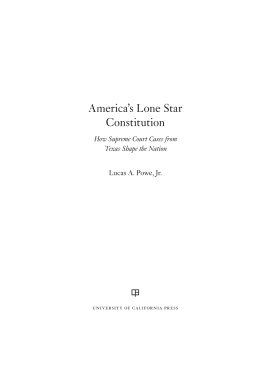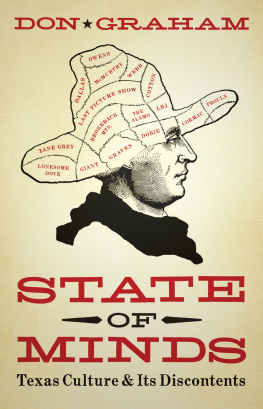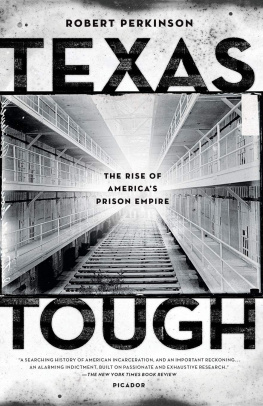Contents
Landmarks


CONTENTS
TO ADULTS WHO CARE FOR
TROUBLED AND LONELY CHILDREN
EVERYWHERE;
AND TO MY OWN CHILDREN,
ALEXANDER SAM
AND
GWENDOLYN SARAH
To enter ones ownself, it is necessary
to go armed to the teeth.
PAUL VALRY

AUTHORS NOTE
I spent nine months inside the Giddings State School, much of it behind a one-way mirror in the Capital Offenders group room. The events described are based primarily on these youths narratives. They are the best sources on themselves. I also had access to case files during daily meetings with psychologists, who read sections aloud as they were preparing for a group, or going over events that had occurred during a group.
Dialogue that appears in quotation marks is taken verbatim from the group room or was said directly to me. The youths narratives of events were checked against police reports, trial transcripts, and interviews with parents and the victims of crimes. Steve Robinson, executive director of the Texas Youth Commission while I was in the Giddings State School, asked that I change the first names of students and alter the places where they committed their crimes. I have done both.
Citations for studies and statistics along with supporting material can be found in the notes section at the end of the book.

INTRODUCTION
THE TOUGHEST PRISON IN TEXAS
The way legendary singer-songwriter Billy Joe Shaver sees things, the town of Giddings (pop. 5,100) is right there where the best is, smack dab in the heart of Texas.
Central Texas is post oak country, gently rolling savanna between the Colorado and Brazos rivers where the farmers raise peanuts and small herds of cattle graze on coastal Bermuda grass. Deer hide in cedar thickets, and deep in the night, coyotes work themselves into a frenzy. Here and there, rigs that look like giant grasshoppers suck oil from pockets deep in the earth. The area was settled by Germans and Czechs in the mid-1800s and is part of the Barbecue Belt that surrounds Austin, fifty miles to the east. Austin prides itself on being the Texas capital, the live-music capital of the world, and the high-tech center of the Southwest, but its influence doesnt extend to Giddings.
The town itself is a jumble of aging one-and two-story brick buildings, furniture stores, fast-food outlets, and gas stations, and like many another raw-looking Texas town, it makes up in friendliness what it lacks in charm. When people ask, How you doin today? they actually want to know. We like to think of Lee County as one big family, a deputy sheriff tells a newcomer during a conversation in the Wal-Mart.
The four-lane artery that runs between Austin and Houston, Highway 290, runs right through Giddings, and traffic pounds the town day and night. Except for five traffic lights, there is not much to stop for. Texas has some outrageous Victorian-era courthouses, and the Lee County Courthouse in Giddings is a redbrick monstrosity sprouting gables like malignant growths. The other landmark is City Meat Market, a hard-core, eat-it-with-your-fingers-off-butcher-paper barbecue joint where a big smoker turns brisket into gourmet fare and the smell is as heavy as the potato salad.
Most travelers blow through without noticing a lonely little green sign across from the Ramada Inn, pointing to an institution that, in certain circles, has made the name Giddings famous. Turn down a country road, pass a played-out oil field and a scrubby pasture where a few head of Brahma graze (theres a small herd of genuine Texas longhorns just up the road), and you arrive at the gate to the biggest employer in town. Almost four hundred people work at the State School, or, as the locals say, with those kids out there. Everyone in Lee County knows someone who works there, or has a relative, or maybe two, who does.
The Giddings State School gets the worst of the worst, the four hundred most heinous youthful offenders in Texas. Across the country, the school is famous in juvenile justice circles for its aggressive treatment programs. Locally, the institution is something of an island, cut off from the town that gives it its name. On Friday nights in the fall the high school football team, the Giddings Buffalos, plays in a stadium that seats twice as many people as there are in town. Demand for tickets is so great the Buffalos sell reserved seats. In the two decades the State School has fielded a football team, the Giddings Indians have had only one losing season, a record that would make the coach the toast of any Texas town. But when Sandy Brown walks into the Texas Grill, a popular truck stop, no one recognizes the Indians coach.
To Johnnie Christiansen, who has been cutting hair in his two-chair City Barber Shop for thirty years, the State School is like the Monday cattle auction, a local point of interest that long ago faded into the landscape.
I never been out there myself, but I hear they take real good care of kids, Johnnie says. I hear when they leave, most of em dont come back.
The Giddings State School is the flagship of the Texas Youth Commission, a chain of thirteen secure facilities scattered across the state that has around four thousand youthful offenders under lock and key. The State School does not look like a typical prison. Take away the fourteen-foot steel fence with motion detectors that surrounds the fifty-five-acre campus and it could pass for a classy southwestern prep school. The grounds are lush and dotted with oaks. Limestone walls shade carefully tended flower beds, water sparkles in a reflecting pool. The biggest building on campus, the high school, is shaped like a starfish, with corridors radiating off a glassed-in central area. The chapel has a dramatic, radically tapering steeple that pierces the sky like a lance. Rainwater running off copper roofs has stained rough-cut limestone facades green, giving the campus an aged, tradition-rich feel.
When it opened in 1972, the State School was intended as a facility where judges could send kids from broken homes, hoping they would stay long enough to earn a high school diploma. Above anything else, kids whose homes have been shattered hate it that they do not have a family. Some told themselves that this was about as good as things were likely to get and adjusted to the State School. But for a significant number who found themselves alone in the world, it did not matter how pastoral the setting was, or how caring the teachers were, or that the cottages were spotless and the food wasnt bad. Every day in a thousand ways, the State School kept reminding them they did not have a home of their own. A fair number took off running, as kids always have from orphanages, no matter how euphemistically they are named.
The locals kept complaining about the runaways and by the late 1970s, congregate-care facilities for youth who had no criminal records were becoming as outmoded as orphanages. Social workers scrambled to place orphans and abused and neglected children in long-term foster care, where they could grow up in conditions that as nearly as possible approximated those of a family of origin. In 1978, the Texas Youth Commission put up the fence and began transforming Giddings into a high-security institution. Youth who came from broken homes were replaced by youth who, through acts of violence, had broken up homes. The State School became a kind of barometer measuring one of the ugliest trends sweeping across Texas and the rest of America.











